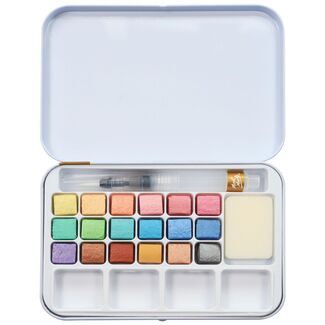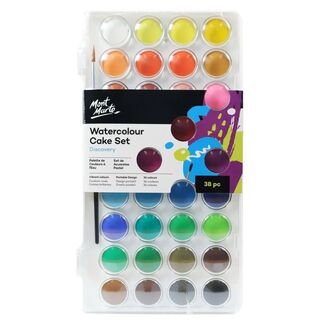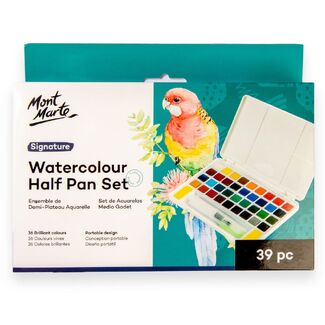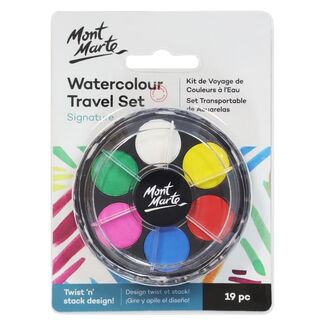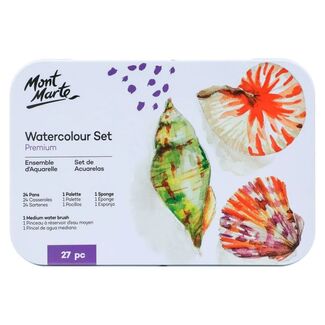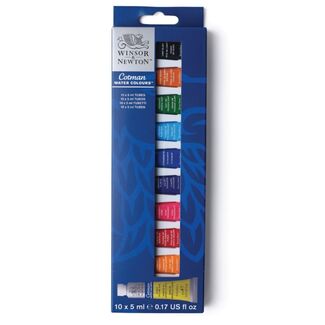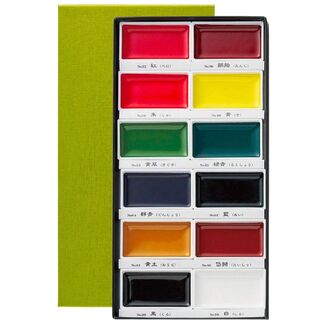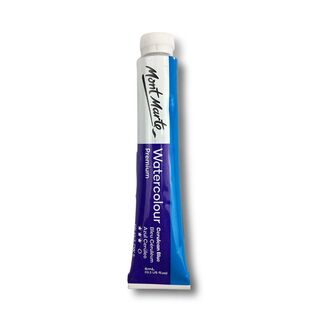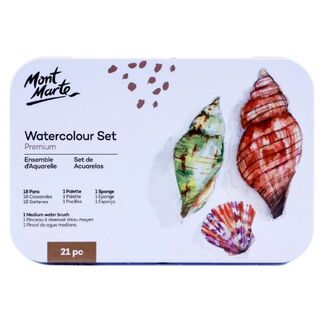Watercolour painting is a beautifully expressive medium that suits beginners, hobbyists and experienced artists alike. Its fluid, buildable nature allows for everything from soft atmospheric washes to detailed illustrations and vibrant layered artworks. No matter your style or subject matter, starting with the right materials makes all the difference to how your colours behave, blend and shine on the page.
At Art Shed, we stock a curated range of student and professional watercolour paints to support artists at every stage of their creative journey. From accessible beginner sets to artist-grade tubes and pans, our selection includes trusted favourites like Mont Marte, Art Spectrum, Winsor & Newton, and the richly pigmented Kuretake collections. Each offers reliable performance, strong colour payoff and smooth handling across a variety of techniques.
If you're assembling your first toolkit or refining your current setup, pairing your paints with quality watercolour paper, well-made watercolour brushes, and dependable painting accessories will help you achieve consistent, long-lasting results. And if you're unsure where to begin, our team of real artists is here to guide you, ensuring you choose materials that genuinely support your style and goals.
Finding the Best Watercolour Paints for Your Style
Choosing the right watercolour paints can shape everything about your creative experience. Student-grade watercolour paints are ideal for beginners, classrooms and artists developing foundational skills. They’re affordable, forgiving and perfect for learning without worrying about wasting materials.
Artist-grade or professional watercolour paints offer richer pigments, cleaner mixes and exceptional lightfastness, giving your colours a noticeable boost in vibrancy and longevity. Popular options from Mont Marte, Art Spectrum, Winsor & Newton, and Kuretake support a wide range of professional techniques, from delicate glazing to rich, expressive colour work.
Watercolour paints come in two main formats:
Tubes — ideal for bold washes, larger artworks and generous colour mixing.
Pans / Half Pans — compact, tidy and easy to transport, perfect for sketchbooks and plein-air painting.
Watercolour sets bring everything together in a curated palette, making them a convenient choice for beginners, classrooms or gifting.
Essential Tools — Paints, Brushes & Paper
Watercolour Paints
Watercolour paints are known for their transparency, blendability and ability to build soft layers. Whether you choose tubes or pans, your format will influence how you work: tubes offer juicy, highly pigmented mixes, while pans make it easy to paint on the go with minimal fuss.
Brushes
A good watercolour brush should hold plenty of water, maintain a fine point and release colour smoothly.
Common choices include:
Round brushes — versatile, precise and ideal for everything from detail to general strokes.
Flat brushes — perfect for washes, sharp edges and broad areas of colour.
Mop brushes — hold large amounts of water for fluid, expressive washes.
Look for brushes with good water retention (synthetic blends, taklon and sable are popular options).
Paper
Your paper will change everything about how your paint behaves.
Cold press watercolour paper — lightly textured and the most versatile choice for beginners and professionals.
Hot press watercolour paper — smooth surface ideal for fine detail and illustration work.
For best results, choose 300 gsm watercolour paper, which resists buckling and handles layering beautifully.
Tips for Achieving Vibrant, Long-Lasting Watercolour Results
Strong, lasting colour starts with understanding pigment load and lightfastness. Artist-grade paints typically include clear lightfastness ratings so you can choose colours designed to resist fading, especially important for framed or gifted artworks.
Your tools play just as important a role as your paint.
Quality watercolour paper absorbs water evenly, keeping your washes smooth, while well-made watercolour brushes give you precision and control. Round, flat and mop brushes all offer different strengths depending on your technique.
Layering is essential for building depth. Start with light washes, allow each layer to dry completely and build colour gradually using glazing or wet-on-dry techniques. If your paints dry out on the palette, don’t stress, watercolour reactivates instantly with a little water.
Fundamental Watercolour Techniques
Wet-on-Wet
Applying wet paint onto wet paper creates soft edges, flowing gradients and atmospheric effects. Ideal for skies, backgrounds and abstract work.
Wet-on-Dry
Applying wet paint on dry paper gives more control, crisp lines and defined shapes. Great for details, outlines and layered depth.
Layering & Glazing
Because watercolours are translucent, layering allows you to build richness and create dimensional colour. Always let each layer dry before adding the next to avoid muddying.
Lifting
A damp brush, tissue or sponge can lift pigment to create highlights or fix soft mistakes, a handy technique for beginners and pros alike.
Frequently Asked Questions About Watercolour Paints
What’s the difference between student-grade and artist-grade watercolour paints
Student-grade paints use less pigment and more filler, making them affordable and forgiving. Artist-grade paints from brands like Art Spectrum and Kuretake offer stronger colour, cleaner mixes and higher lightfastness for long-term durability.
Are tube or pan watercolours better for beginners
Both are beginner-friendly. Tubes offer stronger pigment and are ideal for larger, expressive work. Pans are compact, easy to control and great for travel or sketchbooks.
How do I stop my watercolour paint from drying out
You can’t, but that’s the nature of the medium. Watercolours are meant to dry and be reactivated. A little water or a fine mist will bring them back to life.
Which paper should I use with watercolour paints
Choose 300 gsm watercolour paper. Cold press offers a textured, versatile surface, while hot press is smooth and great for fine detail.
Resources, Tutorials & More
Ready to grow your skills
Explore our guides, blogs and tutorials for watercolour-friendly tips and inspiration.
Watercolour Blogs and Resources:
Product guides
Kuretake Gansai Tambi Watercolour Set: Bold, Authentic Japanese Colour
Winsor & Newton Revival Colours: A Timeless Palette for Modern Artists
Education
A Guide to Watercolour
How to Stretch Water colour Paper
4 Tips for Choosing and Using Watercolour Paper
Techniques and tutorials
How to paint fruit using watercolour paint
12 Textures and Techniques Using Watercolour Paint
Need personalised advice
Our team is made up of real artists who genuinely care. Contact Us anytime for recommendations or help choosing the right paints, brushes and paper for your style.









